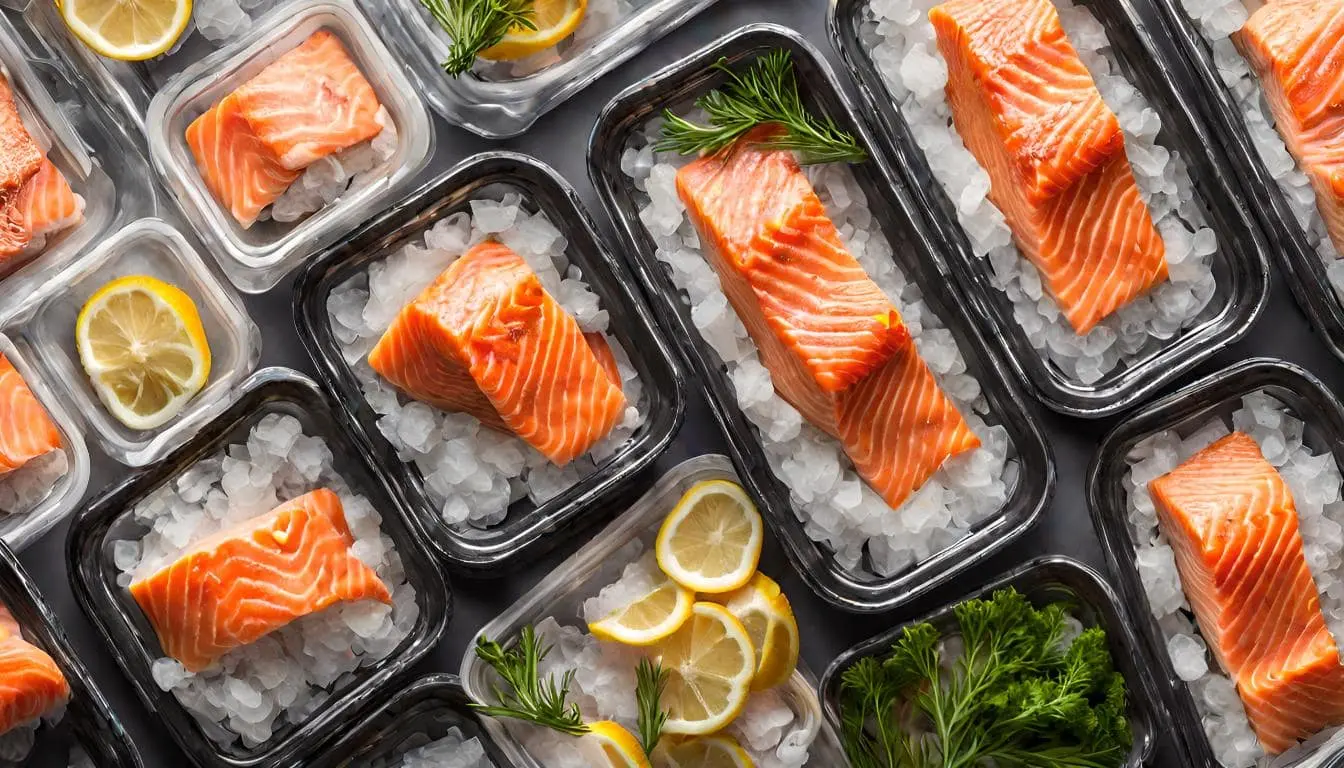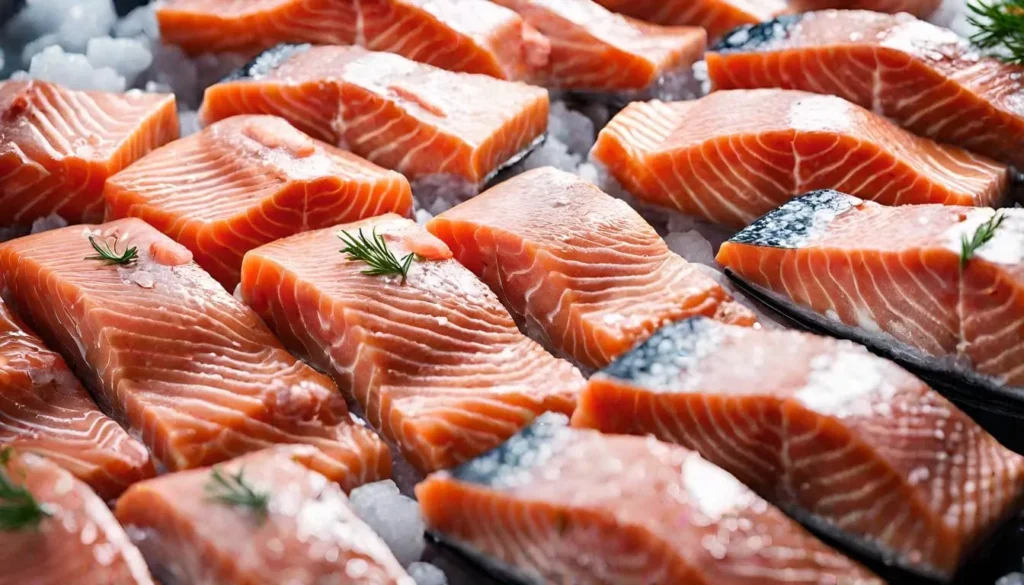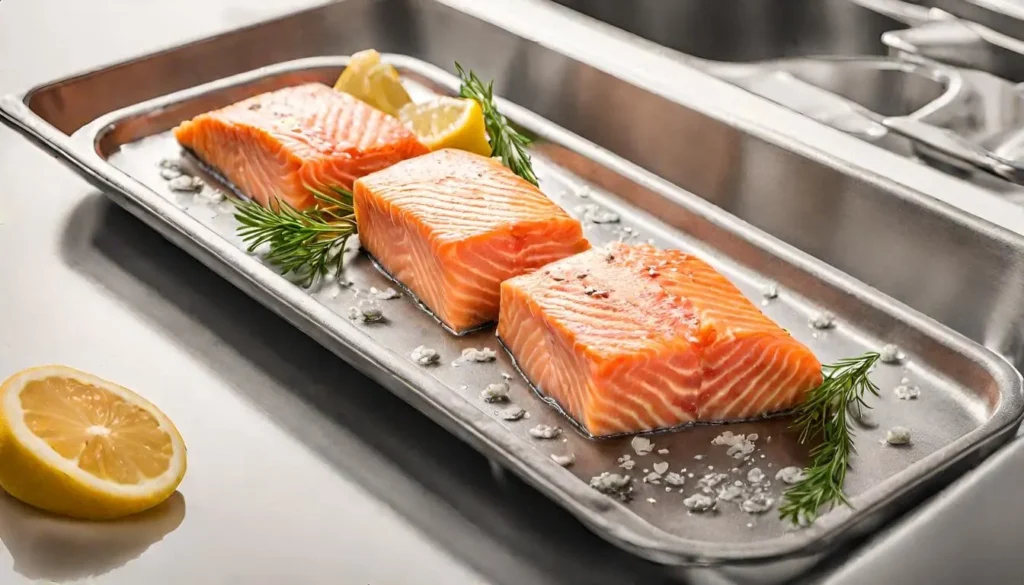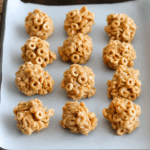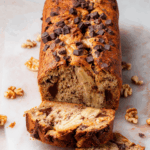Introduction to Proper Storage of Cooked Salmon
Salmon, a delightful and nutritious fish, often finds its way into our meals. But what happens when you have leftovers? Understanding the proper storage of cooked salmon is key to enjoying it safely later on.
Importance of Safe Fish Consumption
Fish, like salmon, is more than just a tasty meal; it’s a powerhouse of nutrients. However, it’s also prone to bacterial growth, making safe storage practices essential. Ensuring that your leftover salmon is stored correctly is not just about taste, but also about your health and safety.
Overview of Cooked Salmon Shelf Life
The shelf life of cooked salmon in the fridge is a topic surrounded by various opinions and practices. While some are overly cautious, others might be too lax. The truth lies in understanding the science behind it. Cooked salmon can be safely stored in the fridge, but for how long? This article aims to clear the air, offering you the best practices for storing your cooked salmon.
Key Factors Influencing Salmon Freshness
When it comes to enjoying leftover salmon, understanding the factors that influence its freshness is crucial. Let’s unravel the mysteries that determine how long your cooked salmon can stay delectable and safe in the fridge.
Initial Freshness of Salmon
The journey to a delicious leftover salmon meal begins way before cooking – it starts at the point of purchase. The initial freshness of the salmon plays a pivotal role. Fresh salmon, either just caught or properly stored at the market, sets the stage for longer shelf life after cooking. If the salmon was already nearing its own shelf life before cooking, the time you can safely store and consume it post-cooking diminishes significantly.
Refrigeration and Bacterial Growth
Refrigeration is like a time machine for food, slowing down the clock on spoilage. However, it’s not a magic wand. It slows but doesn’t halt bacterial growth. The temperature in your fridge, ideally set below 40°F (4°C), is a battlefield where the goal is to slow down bacterial proliferation. The way you store the salmon in the fridge also matters. Airtight containers or tightly wrapped foil can be your best allies in keeping your cooked salmon fresh and safe.
Repeated Freezing and Thawing
A common misconception is that you can repeatedly freeze and thaw salmon without consequences. Each cycle of freezing and thawing can compromise the quality and safety of the salmon. If your cooked salmon has been frozen and thawed multiple times, its shelf life in the fridge might be shorter than expected. This process can affect the texture, flavor, and, most importantly, the safety of the salmon.
Proper Storage Techniques for Cooked Salmon
Storing cooked salmon correctly is an art that ensures its taste and safety are preserved. Let’s walk through a step-by-step guide to store your cooked salmon in the fridge effectively.
Cooling Down to Room Temperature
First things first, let your cooked salmon cool down to room temperature. Rushing it into the fridge while it’s still hot is a no-go. Why? Hot food can raise the fridge’s internal temperature, creating a playground for bacteria. Plus, trapping heat in a container can turn into a moisture fest, leading to a soggy and potentially spoiled salmon. So, patience is key here. Let it sit out, but not for too long – you don’t want it to become a bacteria buffet.
Timely Refrigeration
Timing is everything. The golden rule? Don’t let your cooked salmon sit out for more than two hours. Beyond this time frame, the risk of harmful bacterial growth spikes. Remember, it’s a race against time and bacteria, and you want to win. So, once your salmon hits that room temperature sweet spot, it’s time to move to the next step.
Airtight Sealing Methods
Now, let’s talk about sealing the deal – literally. Airtight containers or wraps are your best friends in preserving the freshness of cooked salmon. Whether you choose a container or go for the classic cling film and foil combo, ensuring that air exposure is minimized is crucial. Air is the enemy here; it brings in unwanted bacteria and can dry out your salmon. Seal it tight to keep it right.
Optimal Refrigerator Placement
Last but not least, where you place your salmon in the fridge matters. The goal is to find the coldest spot. Usually, the bottom shelf or drawer is your best bet. Why? Because it maintains a consistent cool temperature, away from the fluctuating warmth each time the fridge door opens. Also, remember to label your container with the storage date – it’s a simple step that can prevent a world of doubt later on.
Enhancing Your Cooked Salmon Experience
To make the most out of your cooked salmon, it’s not just about how you store and reheat it, but also about the quality of the fish you start with and how you use the leftovers. Let’s explore some additional considerations to elevate your cooked salmon experience.
Choosing Quality Salmon
The journey to a delightful salmon dish begins at the point of purchase. Opt for fresh, high-quality salmon for the best results. Look for bright, clear eyes and shiny, moist skin when selecting whole fish. If you’re buying fillets, they should be firm and free from any fishy odor. Wild-caught salmon is often recommended for its superior flavor and texture, but responsibly farmed salmon can also be a good choice. Remember, the better the quality of your salmon, the more enjoyable your meals will be.
Health Benefits of Salmon
Salmon isn’t just tasty; it’s packed with health benefits. It’s a rich source of Omega-3 fatty acids, known for their heart health and anti-inflammatory properties. Salmon is also high in protein and essential vitamins like B12 and D. Regular consumption of salmon can contribute to improved brain health, better cardiovascular health, and a stronger immune system. Incorporating salmon into your diet is not just a culinary choice but a health-conscious decision as well.
- For those mindful of their sodium intake, explore our variety of low sodium salmon recipes that complement a healthy diet.
Creative Leftover Ideas
Leftover cooked salmon can be more than just a reheated meal; it can transform into an entirely new dish. Flake the salmon and add it to salads, pasta, or make it into a salmon salad sandwich. You can also incorporate it into omelets or scrambles for a protein-packed breakfast. For a quick and easy meal, mix it with some veggies and make salmon patties. The possibilities are endless, and with a bit of creativity, your leftover salmon can be a star ingredient in many delicious recipes.
- Transform your cooked salmon into a wholesome meal with this salmon and wild rice recipe, perfect for a nutritious dinner.
Frequently Asked Questions
When it comes to storing and consuming cooked salmon, several questions often arise. Here are the answers to some of the most frequently asked questions to guide you through the process.
Can Cooked Salmon Last Beyond 3 Days?
The general guideline is to consume cooked salmon within three days for optimal safety and quality. However, under ideal storage conditions, it might be safe to extend this to four days. Beyond this period, the risk of foodborne illnesses increases. It’s important to remember that these are guidelines, and individual circumstances can vary. If there’s any doubt about the salmon’s freshness, it’s safer to err on the side of caution and discard it.
How to Identify Spoiled Salmon?
Recognizing spoiled salmon is crucial to avoid foodborne illnesses. The key indicators include a foul or ammonia-like odor, a slimy or sticky texture, and visible signs of mold or discoloration. Fresh salmon should have a mild scent, be moist and flaky, and maintain its original color. If your salmon exhibits any of the spoilage signs, it’s best to dispose of it immediately.
what is the Best Practices for Reheating Cooked Salmon ?
Reheating cooked salmon while preserving its quality involves gentle heating methods. The oven is a great option: preheat it to 275°F (135°C), place the salmon in a baking dish, cover it lightly with foil, and heat it until it’s warm throughout, usually about 15 minutes. Alternatively, you can reheat it on the stovetop using a skillet over low heat. Add a bit of water or broth to keep the salmon moist, cover the skillet, and heat gently. It’s advisable to avoid using a microwave for reheating salmon, as it can dry out the fish and heat it unevenly.
Conclusion
As we conclude our comprehensive guide on storing cooked salmon, let’s revisit the key points to ensure your salmon remains both a safe and delicious choice.
Recap of Key Points
Storing cooked salmon correctly is essential for maintaining its quality and ensuring food safety. Remember the 3-Day Rule for optimal freshness and safety, and always store your salmon in the fridge within two hours of cooking. Cooling it to room temperature before refrigeration, using airtight containers, and placing it in the coldest part of your fridge are crucial steps. Be vigilant for signs of spoilage, such as off-odors, discoloration, or a slimy texture. When reheating, opt for gentle methods like the oven or stovetop to preserve its flavor and texture.
Encouraging Safe and Delicious Consumption
Cooked salmon offers a delightful culinary experience, but it’s important to handle it with care. By following the guidelines outlined in this article, you can enjoy your salmon safely and make the most of your meals. Don’t forget the importance of starting with high-quality salmon and exploring creative ways to use leftovers. Salmon is not just a versatile and delicious ingredient; it’s also packed with health benefits that make it a valuable addition to your diet.
In conclusion, the key to enjoying cooked salmon lies in understanding and implementing proper storage and reheating techniques. By doing so, you ensure that every salmon dish is not only a treat for your taste buds but also safe for your health. Here’s to many more enjoyable and safe salmon meals!

